Simon Eckerström Liedholm: Persistence and reversibility of wild animal welfare interventions
By EA Global @ 2020-11-09T21:17 (+19)
This is a linkpost to https://www.youtube.com/watch?v=6NAibN6M5YM&list=PLwp9xeoX5p8NfF4UmWcwV0fQlSU_zpHqc&index=12
When we try to improve wild animal welfare, we want the effects of our efforts to persist long into the future. However, we also want to maintain the ability to undo our actions if they turn out to be harmful. In this talk, Simon Liedholm of Wild Animal Initiative outlines how we can optimise these two objectives, and applies the framework to some specific examples.
We’ve lightly edited a transcript for clarity. You can also watch it on YouTube and read it on effectivealtruism.org.
The Talk
Bridget Williams (Moderator): Hi, everybody. I heard everybody's EAGx Virtual is going well so far. My name's Bridget and I'm the emcee for this session, “Persistence and reversibility of wild animal welfare interventions,” with Simon Eckerström Liedholm.
To start, we'll have a 10-minute talk by Simon, and then we'll move on to a live Q&A session where he'll respond to [audience members’] questions. [...]
Now I'd like to introduce our speaker for this session. Simon Eckerström Liedholm is a researcher at Wild Animal Initiative. He has worked on questions of strategy and prioritization, and is currently investigating fertility control for wild animals. He finished his PhD in ethology at Stockholm University last year, and is also a board member of Effective Altruism Sweden. Here's Simon.
Simon: Hi, everyone. My name is Simon and I'm a researcher at Wild Animal Initiative. Our mission is to conduct and facilitate research on how to improve the lives of wild animals. Today, I'm going to be talking about the persistence and reversibility of wild animal welfare interventions.This talk is based on a report that we published in December 2019 on this topic.
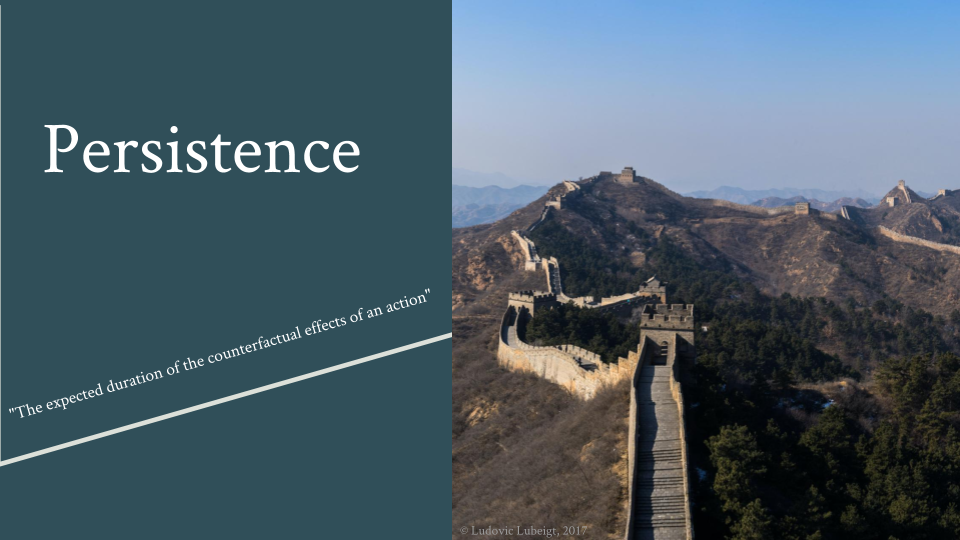
I will start by defining what I mean by “persistence”: the expected duration of the counterfactual effects of an action. I say “expected” [because] we are interested in [an action’s] likely persistence before it has been taken, and by “counterfactual,” I mean that we are interested in effects that wouldn't have come about otherwise.
I do not classify repeated actions that sustain something as persistence. For instance, even though your room might stay clean for years on end, any individual act of cleaning will not have a persistent effect (although if you know a way to do that, please tell me).
We should care about persistence because an intervention that lasts longer, if all else is equal, is preferable to a shorter one. There's more time for beneficial effects to accumulate.
To give an example of a persistent effect, consider the Great Wall of China, parts of which are more than 1,000 years old. Anecdotally, it seems to affect gene flow between populations of plants on different sides of the wall, so possibly it will also affect animal populations.
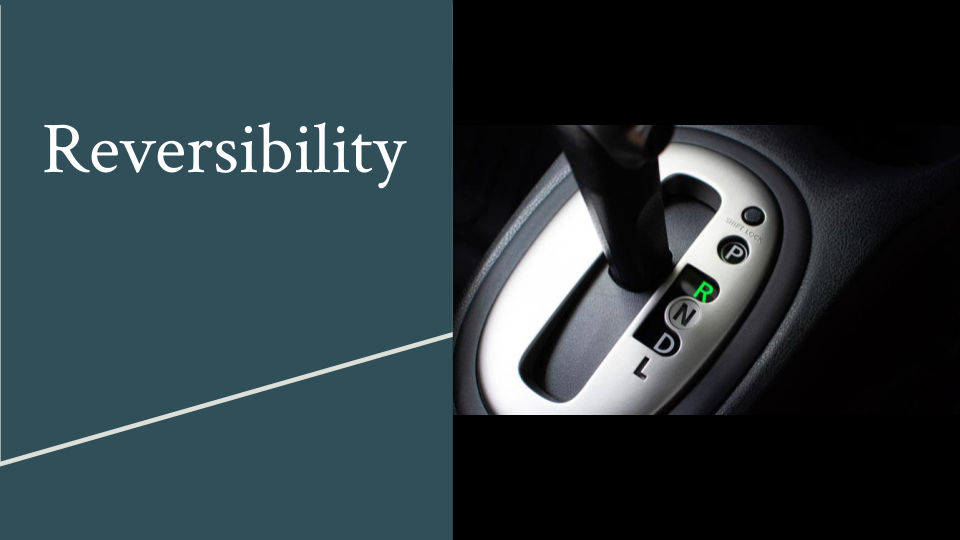
We'll get back to persistence later, but for now let's turn to reversibility. Reversibility has turned out to be somewhat harder to pin down, so if you want to read more about the details of our thinking on this, you should check out the report.
In any case, I define “reversibility” as the fraction of the effects of an intervention that should be reversed so as to maximize the expected utility of a reversal [that is, the benefit of the reversal minus the cost of the resources used]. This definition might not be the first thing that comes to your mind when you're thinking about how reversible an action is, so I'll try to explain my thinking.
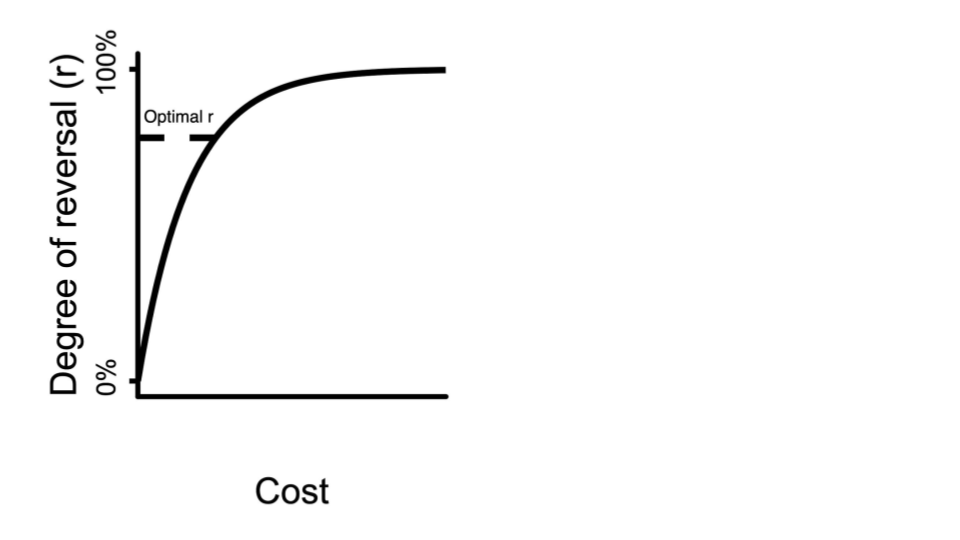
The first observation to make is that trying to reverse the effects of an action might be easy at first, but it will become progressively harder. In other words, there might be diminishing returns to reversing an action, as I show [in the slide above]. As an example, let's say you spill wheat flour on your floor, and then you try to clean it up. Getting most of it off the floor will be easy, but making sure that every single particle is taken care of will be much harder.
Just because the last particle is virtually impossible to find doesn't mean that [the spill isn’t] at least somewhat reversible; therefore, the likelihood of 100% reversal might not be a good proxy for reversibility.
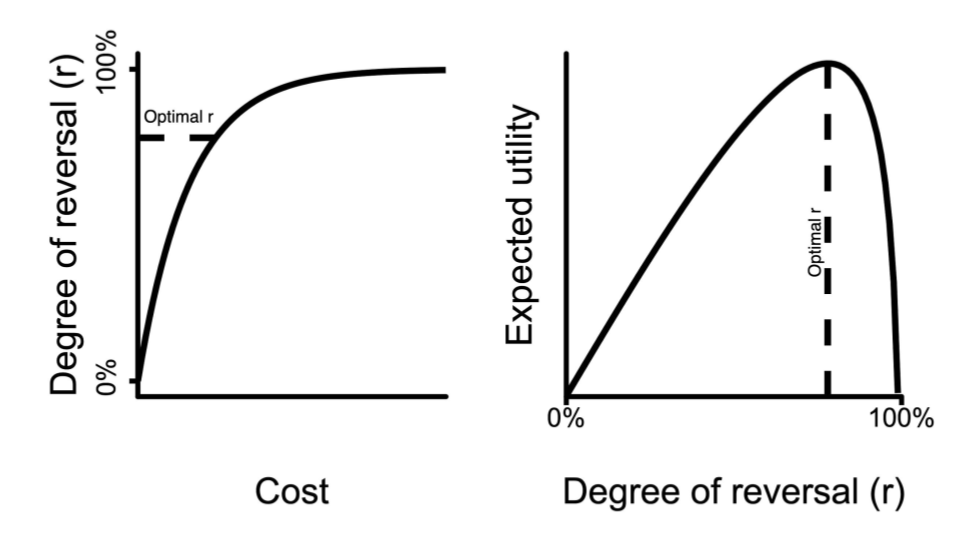
We should also take into account the opportunity cost of reversing an action, where we forsake the ability to use our resources elsewhere. The optimal degree of reversal could be lower than a complete reversal if our efforts have diminishing returns. In the hypothetical example [in the slide], trying to get close to a 100% reversal could cause us to waste more and more resources — with a smaller and smaller payoff.
Stepping back a bit, why should we care whether an action is reversible or not? First, reversible actions maintain option value, and allow us to avoid bad, unforeseen consequences. This is especially important when it comes to wild animal welfare, where there's a lot of uncertainty.
Second, to get buy-in from decision makers and the general public, we [need] to show that we are not acting recklessly or promoting reckless behavior.
There are two other [factors] that I think affect the importance of reversibility: future values and future knowledge. I will start by talking a bit about future values.
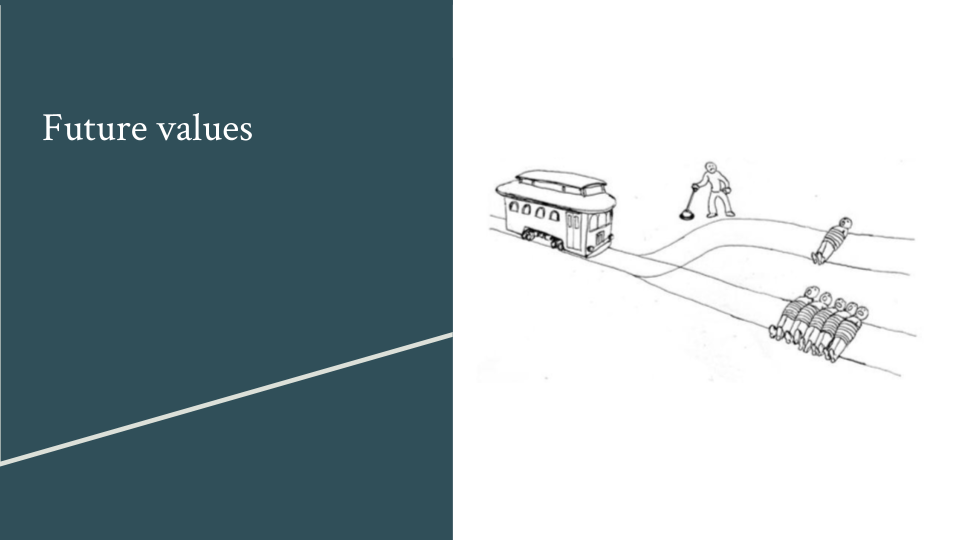
There are many things that we don’t know about the values of our descendants. Will our values drift randomly, or will they improve in some sense? To what extent can our descendants' values be thought of as idealized versions of humanity's current values?
These are questions that will influence the importance of reversibility. If the values of future humans will get better in some sense, maintaining reversibility will be very important. If the opposite is true, reversibility will be less important. [Editor’s note: This is because we want future humans with better values to be able to reverse our interventions, because we expect they’ll have good reasons. If future humans have worse values, we may not want them to be able to reverse our interventions, because we would expect them to have reasons we wouldn’t endorse.]
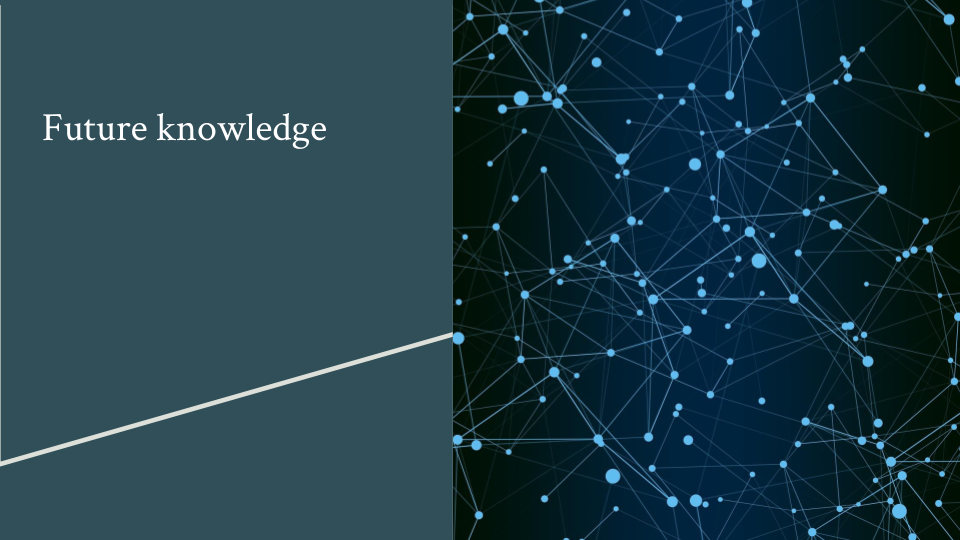
The accumulation of knowledge will also affect the importance of reversibility. If our understanding of the natural world keeps improving, we might want to be able to let our descendants second-guess decisions that we make today, which means that [developing] reversible interventions will be much more important than [developing] persistent interventions.
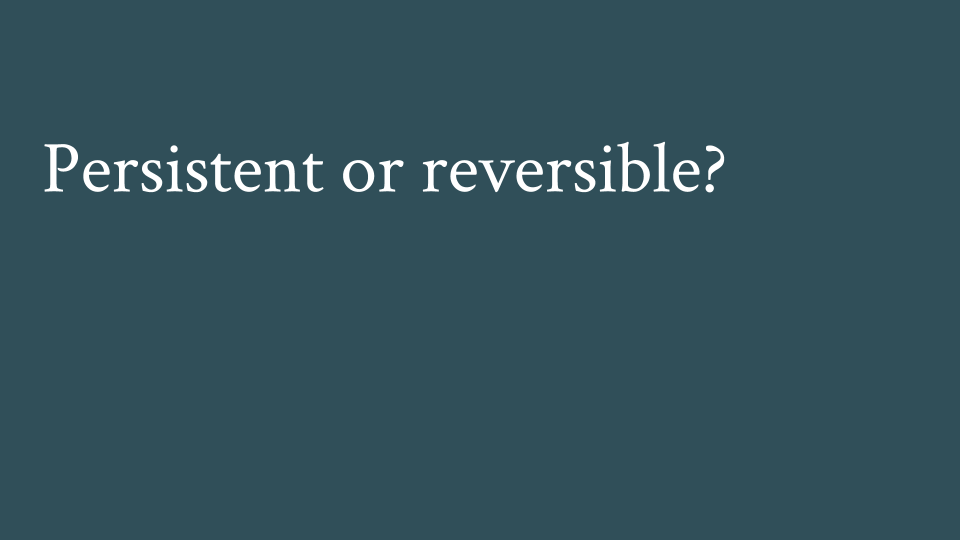
On the whole, it seems that we want interventions that are both persistent and reversible, but as you might have already noticed, the concepts are highly related. Interventions that are very persistent will likely be hard to reverse, and this is because the act of reversing an intervention will decrease its persistence. That means we will often have to make tradeoffs between persistence and reversibility — and, as I mentioned, there are good reasons to avoid persistent effects that cannot be reversed.
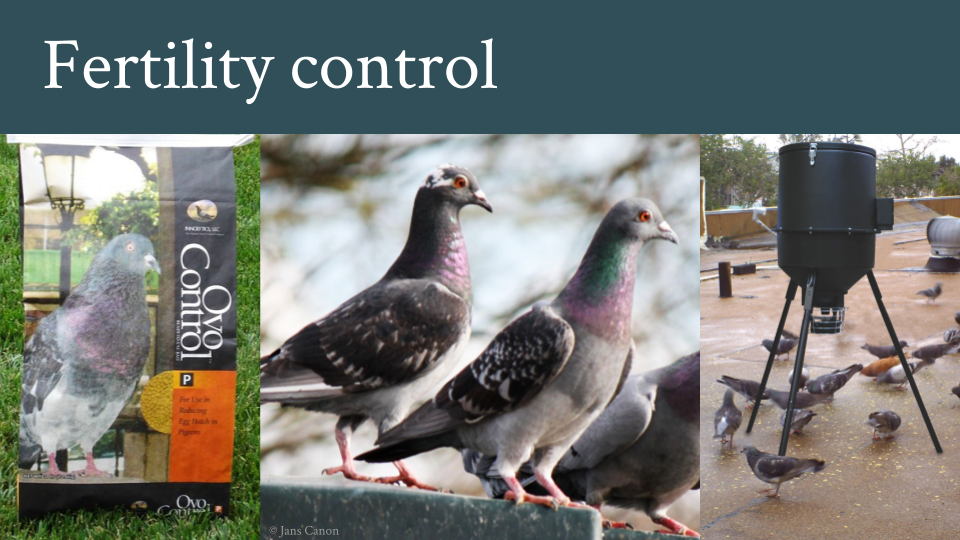
To tie this abstract reasoning into concrete examples, a low-persistence intervention that we are investigating right now is fertility control for pigeons using nicarbazin. OvoControl is the name of the commercial product in the US.
Fertility control seems like a promising way to reduce juvenile mortality and competition for resources, basically leaving more resources for remaining individuals in the population. Even though there might be [bad] effects of reducing populations of pigeons using birth control, the effects of the active ingredient in nicarbazin are very short-lived, and breeding resumes after a few days when you stop treating the pigeons with the nicarbazin. [That is, the intervention has low persistence but high reversibility.]
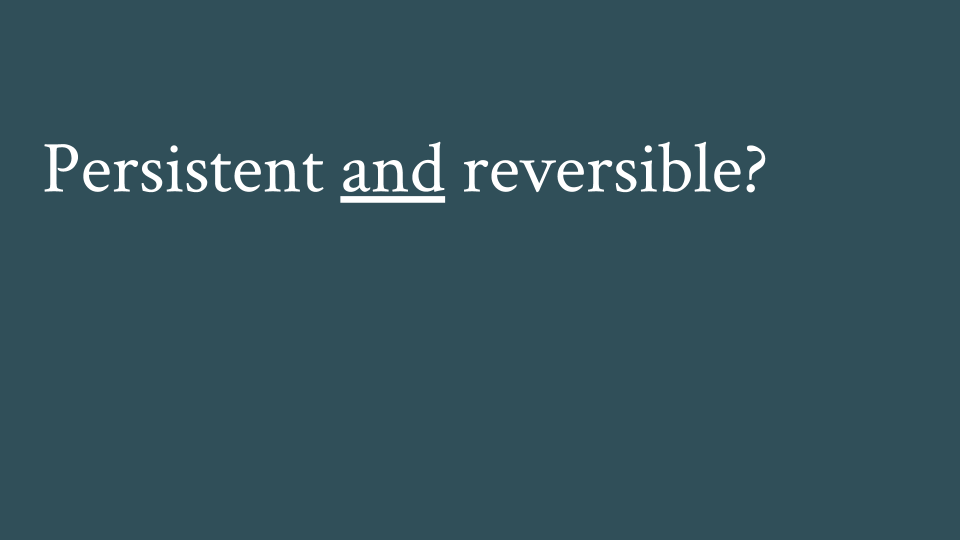
That's pretty promising, but what if there’s a way to design interventions that are both persistent and reversible?
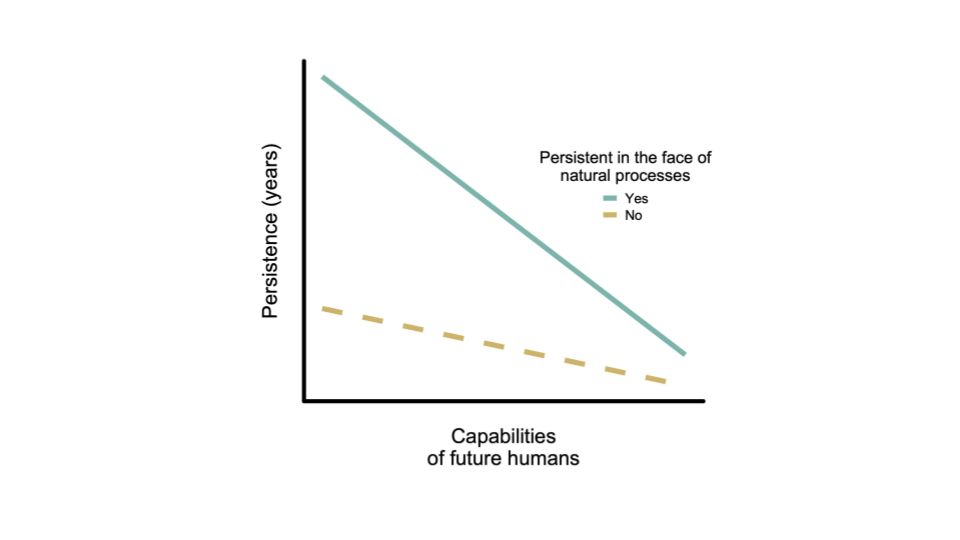
These are two lines representing hypothetical interventions under different levels of human capability. On the y-axis, you see the persistence of the interventions. If we look at the far left-hand side of the horizontal axis, we are in a world where human capabilities have drastically decreased. The green line represents an intervention that has been persistent in the face of natural processes, but as you can see, it's not persistent in the face of human action.
Designing interventions this way [allows us to] retain the ability to reverse the intervention, as long as we have the capability to do so. But the intervention will persist when we either can't or won't reverse it.
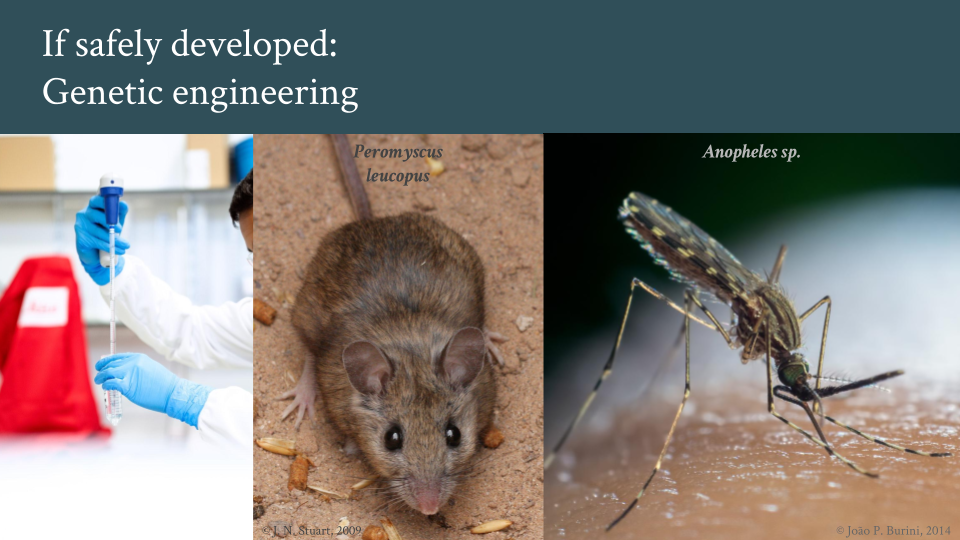
If safely developed, genetic engineering could be an example of a class of interventions that are both reversible and persistent in the face of natural processes. One could utilize [such engineering] in the cellular machinery that preserves genetic material and information [through multiple] generations to make it persistent in the face of natural processes.
At the same time, there is no innate resistance to the tools of genetic engineering, as wild animals haven't been exposed to them. This means that the produced changes can be reversed if we choose to reverse them. Such methods to limit or reverse the effects of introduced changes have been studied for gene drives, which you can read more about in the report.
The use of genetic engineering has been proposed for combating human pathogens. For example, two candidates are white-footed mice, which are vectors for Lyme disease, and anopheles (mosquitoes), which are vectors for malaria. Although genetic engineering in the wild should not be used before we are sure that the tools are safe and work as intended, I'm generally optimistic about using such methods to improve human health.
If we're willing and able to use genetic engineering to help humans in the future, I don't see any reason why we couldn't eventually use it to improve wild animal welfare.
Thank you for listening. Here are some resources you might be interested in.
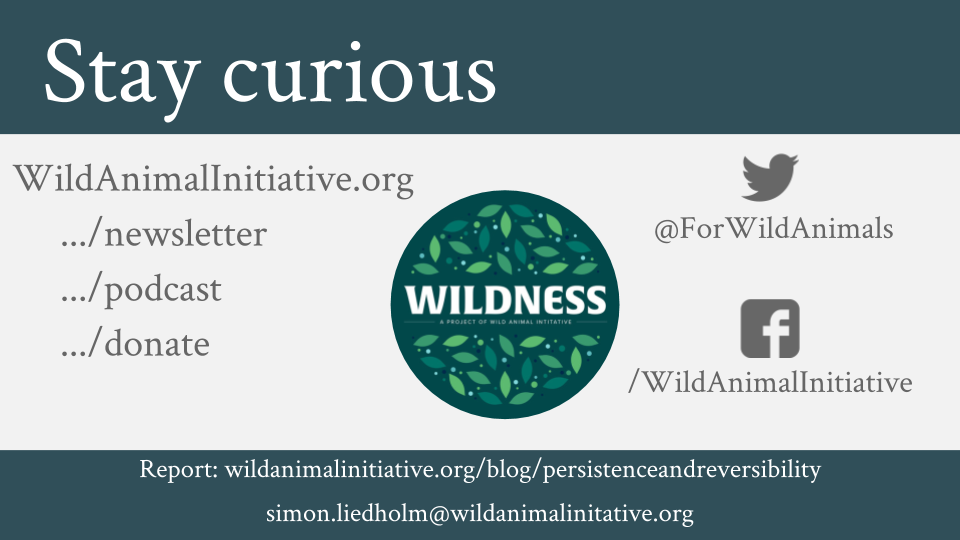
If you want to know more about the contents of this talk, you should check out the report. Also, we have a few episodes of our podcast, Wildness, on our website, which I highly recommend if you want an introduction to wild animal welfare. Thanks.
Bridget: Thanks so much for that talk, Simon, and thank you very much for joining us here for this live Q&A session now. I see we've had a number of questions submitted on the Slider app already.
First of all, welcome, Simon. Thank you for joining me. I'll start with one of my own questions. [Since you] work on fertility control in wild animals, it seems that you must have views on population ethics for animals. What are they, and how does that change what you think about your work and its value?
Simon: Yeah, that's right. I think my view on population ethics is quite close to “the total view,” which means that I'm interested in the sum [over time] of the welfare of a species. It can seem a bit like you're making tradeoffs when using fertility control which will inevitably reduce the population size; you're getting fewer individuals, and potentially less total welfare, but the average welfare is likely increasing. There's going to be an optimal [population density].
My colleague Luke Hecht has written about this. It’s an interesting question. I think that using fertility control will help improve lives when you have intense competition for resources, [which is evident in] very high juvenile mortality. I find it hard to see other ways of improving well-being that are as [effective] as fertility control.
If you look at it from the perspective of the total biomass or available energy [on Earth], reducing one population will potentially increase another population. Therefore, I think if [it’s possible to] keep fertility rates lower for many species, we might get around this problem of changing population sizes by looking far into the future. We might see more individual [welfare improvements]: long lives that are potentially more positive than short lives filled with bad experiences.
Bridget: I think that shows the complexity of the work that you do — that you have to cover everything from moral philosophy, to questions like “Are animals sentient?”, to the impact of different interventions. It's complicated stuff.
Simon: Definitely.
Bridget: Do you have a view on what research is needed most to answer this question? Is there an area where you think there should be more, or less, attention in navigating that scope of research?
Simon: Do you mean generally for wild animal welfare, or something specific?
Bridget: Generally — or, if you prefer to focus on fertility control, that's fine.
Simon: I can answer both. [Regarding] the question of fertility control, we're currently in contact with researchers who seem to be interested in conducting a study on the effects of fertility control on pigeons. That seems promising to me.
I think that the main value at the moment is [that fertility control has the potential to be] one narrow intervention [that has many different] positive effects on welfare — it reduces high fertility rates, juvenile mortality, and resource competition. It might not be net-beneficial. That's unclear. But I think the usefulness of the intervention goes beyond that. It's about trying to find an intervention that's good for pigeons, and is something we can build on for other species. The value of a special intervention like that is [establishing] proof-of-concept.
Bridget: Okay, sure. I think we'll jump to the top-rated question in the Slider now. Someone has used quotation marks around [the following statement], so I think this must be something that you said: “Genetic engineering in the wild should not be used until we're sure the tools are safe.” What evidence counts as “certainty”? It seems like there are a lot of variables to control, so how can you be sure that the tools are safe?
Simon: That's a very good question. I should say that I'm not a geneticist. I've read a lot about these different methods, such as gene drives, and I think that in order to be as sure as [possible] that there aren't large unforeseen negative effects, there's a need for a lot of small-scale experiments and work in the lab to [avoid] accidental releases of modified animals.
Maybe [researchers] could use mesocosms: small, semi-natural environments that are closed off from the world. I think that you could go [far] using those methods. I also think that the researchers working on this — for instance Kevin Esvelt, who is giving a talk on catastrophic biorisks later in this conference — are focusing on how to make those methods safe and reliable.
I'm not sure exactly how I would answer this question. At the moment, it seems clear that more research is needed; that's my answer.
Bridget: Okay. In a somewhat related question, [an audience member] notes that a lot of governments are looking to reduce and control the populations of pigeons, mosquitoes, [and other wild animal populations]. Are they using fertility controls? If not, why not?
Simon: Could you read that again?
Bridget: A lot of governments already seek to control and reduce populations of pigeons, mosquitoes, et cetera. Do they currently use fertility controls? If not, why not?
Simon: In terms of pigeons, I think most [governments] do not use fertility control. It's quite common to use trapping and poisoning, or trying to ward them off in some way. This [is true] for a lot of pest animals. I think fertility control is very new for the species.
In terms of insects, there’s one example that I guess could be called fertility control. It's the sterile insect technique, and I’d [estimate] that it has been used for almost 60 years in the US to reduce populations of screwworm, a fly that is a type of parasite. The female screwworm lays eggs in open wounds on animals, and the larvae eat the flesh. It's very painful for the afflicted animal.
There has been a lot of work to eradicate screwworms from southern North America and basically all of Central America. The screwworm is still present in South America, but I guess [these eradication efforts] could qualify as a fertility control measure. It seems more humane than other methods of resource control and it affects fertility.
But generally, I think it's uncommon.
Bridget: Yes, and it seems like there might be a difference between interventions that aim to [advance] human welfare (for example, mosquito control programs) and [those for which] animal welfare is a primary concern.
Simon: Definitely.
Bridget: A related question is: Could fertility control cause depression among animals?
Simon: Yes, I think that in some cases it can. It's kind of unclear. I've read some reports [suggesting] that the behavior has changed for some mammals. I'm not sure. I suppose that if one takes a consequentialist perspective, some females might suffer the loss of not having offspring, or from thinking that they're having offspring but then [not having them]. Or, it could change their physiology or neurochemistry and make them depressed. But I guess you'd have to weigh that against the potential benefits for juveniles. It would be interesting to see more research on that.
Bridget: Yes, it's a really interesting question. Here’s another about the cascading effects [of interventions targeting one type of animal]: If you intervene with the aim of promoting one species' welfare, what effects will there be on other species? How do you go about including that [factor] in your thinking?
Simon: I’ve thought about that a lot. Generally, it’s tricky. It's hard to estimate even the direct effects of [interventions] on the species that you're trying to treat in some way, so knowing what the indirect effects are is very hard.
Going back to the example of fertility control for pigeons, for instance, I think its main value is as a test case of something we might extend to different species. It seems more plausible to me that that would be net-positive, [versus] changing the conditions for one species to compensate for another species. That could be problematic. Improving the welfare of many species at the same time seems to be a better approach.
But I'm somewhat unsure about that argument. I would be interested in whether someone disagrees with me, and why.
Bridget: Okay, that could be something that people pick up in the small-group discussions [following this talk].
Simon: Definitely.
Bridget: Another question is: Are there any examples of human interventions in ecosystems that have gone well, aside from conservation work?
Simon: I would say that eradicating screwworms seems like something that is pretty clearly a positive, as far as I can tell. It has improved the well-being of domesticated animals, and quite likely wild animals and humans as well.
But it’s very hard to tell when you take into account the indirect effects on the population sizes of other species. The screwworm seems to have a very specific niche — feeding on the flesh of mammals — and I can't see how that is replaced by another species. The effect [of its eradication] would likely be that the populations of wild mammals would increase, and it’s hard to establish what the net effect of that is.
But I'm excited about long-term progress in improving wildlife welfare, and it's more interesting to me when [an intervention] indicates a positive step toward something that can be used on a larger scale, rather than in the margin.
Bridget: Coming back to the focus of your talk on persistence and reversibility, somebody has asked, “To not appear reckless, wouldn't it be better to choose interventions that aren't persistent in the first place, and that need constant upkeep?”
Simon: I think that's a good point — one I tried to make in the talk, actually. I think there's a strong argument for doing that and for at least starting on a small scale. This relates to the uncertainty around effects. If you can reduce the uncertainty, then you might be able to move further on the persistence scale, so to speak.
But I've found at least one example of the negative effect of persistence seeming to come from not being able to reverse something. That is why I think genetic engineering seems promising, at least in theory. Hopefully, we'll be able to perfect these methods so that we can have a persistent effect if we choose not to interfere with the action that we've taken, but will always have the opportunity to reverse the effects to some significant extent.
Bridget: Okay, cool. There's a question about Wild Animal Initiative and incorporating a longtermist perspective — and, more specifically, artificial intelligence — into wild animal suffering. Could you perhaps provide an overview of the organization Wild Animal Initiative and the work happening within the team, and then also address those questions about a longtermist perspective and the potential role of AI?
Simon: Yes, that's good. You might have to remind me of the different parts of that question because there were many.
Bridget: Yeah, no worries.
Simon: I think our main focus [at Wild Animal Initiative] is to foster and facilitate research on wild animal welfare. And that, at least as far as I can see, is directed toward [attempts to make] long-term positive progress, in terms of understanding and taking action to improve wild animal welfare.
I think there are reinforcing effects [at work]: If people think that there are no ways to improve wild animal welfare, they have a much harder time extending empathy toward wild animals. That's one piece of the puzzle; doing more research on how to improve the lives of wild animals [can help] people see that there are things we can do that seem reasonably reliable and promising in the long term.
Specific things that we've been working on, and that I'm excited about, include biomarkers of aging as indicators of cumulative welfare. This is something that Will Bradshaw worked on [in 2019], by looking at telomere attrition to [determine] the effects of stress and negative experiences on physiology. This allows you to measure the attrition of telomeres as a proxy for how much distress [an animal has] experienced during their life. That's something that I find very interesting.
We've also worked on measuring welfare in terms of welfare expectancy. This is something that my colleague Luke Hecht has been working on. Basically, he takes the age-specific mortality — [an animal’s] mortality rate during a certain age interval — and then [explores the results if one] assumes that [mortality] rate is a good proxy of welfare during that period. So, if many individuals die — for example, half of the individuals in that age group — then that indicates that [their well-being probably wasn’t very high during] that interval. Then, he looks across the lifespan of that species to [evaluate their overall welfare]. Does [a given animal’s life] seem like it is [consistently] positive, or does it seem to have a lot of negative experiences? It's hard to know what the [overall] welfare is for a species, so this [approach] measures welfare on a relative [basis]; you can sort of order species in terms of [which ones seem to experience] more positive welfare. I think it's very promising.
My colleague Hollis Howe has worked on humane insecticides, looking at those in use at the moment and trying to figure out which ones seem to be conducive to welfare, or seem to induce less suffering. Maybe the individual dies faster, or we can assess whether it suffers more or less [depending on the insecticide used].
And then there was a question about AI.
Bridget: Yes. What do you think the relevance of artificial intelligence is for wild animal suffering?
Simon: Right. I think it has an impact on the question of persistence. It's fairly relevant to this framework. It seems reasonable to assume that if we manage to create an artificial general intelligence that has extraordinary capabilities compared to humans, and it is able to change the world in ways that would be beneficial from that agent's point of view, we can expect that the world will change quite drastically. I guess that that expectation produces persistence.
If you think it's likely that an artificial general intelligence would make changes that are pervasive in a short period of time — not that far into the future — then that would [indicate] that persistence is likely a lower [priority for our actions] today.
Bridget: There's another question here about the importance of public perception for making progress in the area [of wild animal welfare]. I feel like you touched on that a little bit. More broadly, what's the role of public perception? And is that [a factor for] Wild Animal Initiative [when] deciding what to work on, and what kind of work to do?
Simon: Definitely. I think that's something that's very important to consider. We're not operating in some kind of vacuum, where we strip away all of the people in the world and [fail to] think about [how] they react to our actions.
I think it's a balance. You have to be clear about what we think a good future [looks like], and sort of explain that given certain constraints. We definitely think about public perception a lot.
Bridget: We are coming toward the end of this session, so this will be the last question. To finish up, you [showed a] link to your report on your last slide. What else would you recommend people look into if they're interested in learning more about this topic, and also, what kinds of opportunities might be available to people interested in engaging further?
Simon: That's a good question. I think that if you're interested in the framework of persistence and reversibility, there's a writeup by Stefan Schubert and Ben Garfinkel. It's cited in my report and is on a very similar topic: retaining option value by avoiding highly persistent effects. Other than that, if people want to engage more with this question, I highly recommend that they think about it, write up their thoughts, and expand on it. Prove me wrong if I'm wrong in some sense. It would be very interesting to see more work on this.
Bridget: Great. Simon, thanks so much for joining us today.